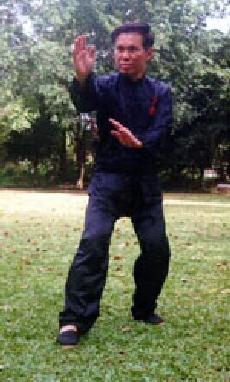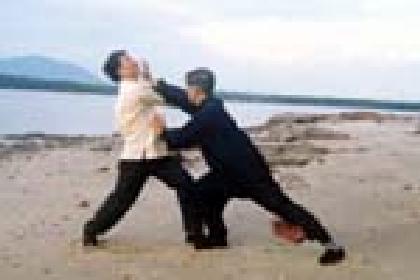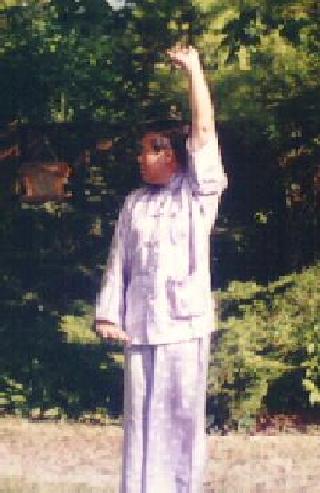October 2003 (Part 2)
SELECTION OF QUESTIONS AND ANSWERS

Sifu Wong demonstrating a Taijiquan pattern. Taijiquan can be practiced by anyone irrespective of his race, culture and religion.
Question 1
In a previous e-mail you mentioned that a person from any religion could do martial arts. I'm a Christian and I'm experiencing great confusion, because I don't understand the theory of Taiji and where chi comes from. Many people say that a Christian can't do martial arts, because he is partaking in an esoteric art, which is against God.
— Ryan, South Africa
Answer
You are confused because you have been given wrong information by uninformed persons. The following explanation will help you to clear your confusion.
There are many types of martial arts, and many of these do not involve the theory of Taiji or chi. Some examples are Western Boxing, Kickboxing, Wrestling, and Fencing. You would therefore have no problem practicing these martial arts. Remember that classic European knights who took part in crusades were pious Christians, and martial arts were an essential part of their life and profession.
Even if we consider martial arts that involve the theory of Taiji and chi, such as Taijiquan and Shaolin Kungfu, there are no valid reasons why Christian cannot practice them, because these martial arts do not involve religion.
Some people are worried because they do not understand the meaning of “Taiji” and “chi”. “Taiji” means the cosmos, and “chi” means energy. Indeed, Christians as well as pious followers of any religions who believe in a reality that goes beyond the present world and physical form, should be in favour of martial arts that deal with the cosmos and energy, over martial arts that do not pay attention to other worlds and deal only with material forms.
Anyone who says it is against Christianity to practice an exoteric art, has lost sight of the historical and cultural roots of Christianity. To Americans and Europeans, as well as South Africans, Christianity was esoteric in both its beliefs and practice. Christianity originated from the Hebrews, who were esoteric in history, culture and other aspects from the perspectives of Americans, Europeans and South Africans, who today form the majority of Christians.
God, of course, does not discriminate against race, history, culture or any other factors. Hence the issue of whether one is against God if he practices an esoteric art, becomes irrelevant.
Question 2
Forgive me for my ignorance, but could you please provide me with a detailed discourse on the theory of chi and its origins. Then I can decide for myself. Please help me, this issue is hindering my progress and weighs heavily on my mind. I seek the truth.
Answer
It is not feasible to provide you with a detailed discourse here; it is also not necessary. A short explanation will suffice.
Chi, or energy, permeates your every cell as well as all the stars and galaxies and everything else. It is omniscient. It has no origins and no endings; it exists at all times. It is omnipresent. It forms everything and works everything, there is nothing it cannot do. It is omnipotent.
If you really want to seek the truth, and therefore are prepared to drop your prejudice, you will notice that you can substitute the word “chi” for the word “God” in the passage above.
It follows logically that by experiencing chi, you may experience God. This was exactly what many people felt when they practiced chi kung from me in my Intensive Chi Kung Courses as well as regional chi kung classes. It was such feelings of awe and wonders that led many people to comment these chi kung experiences gave them tremendous joy, freedom and peace, and which you may read at my “Comments” webpages.
The reality of God is universal but the term “God” is not. What you and other English speaking people refer to as “God”, is referred to by the Spanish speaking as “Dios”, by the Arab speaking as “Allah”, by Hindus as “Brahman”, by Taoists as “the Great Void”, by Buddhists as “the Buddha”, by Zen cultivators as “the original face”, and without disrespect by chi kung practitioners as universal chi, and by scientists as the unified energy field. Unfortunately it is this failure to understand that different words can be used to refer to the same reality that often leads to clashes between peoples and nations.
Question 3
You mention that in Taijiquan and chi kung as well one must inhale through the nose and exhale through the mouth. My teacher taught me to inhale and exhale through the nose only.Which method is correct?
Answer
Both methods are correct. Inhaling through the nose and exhaling through the mouth is referred to as the “martial method”, whereas both inhaling and exhaling through the nose as the “scholarly method”.
As their names imply, the “martial method” is forceful, and is usually used in martial arts. The “scholarly method” is gentle, and is often used in meditation. This is, however, not a rigid rule. In combat when one has to spar for a long time, for example, a skilful combatant may gently close his mouth and use only his nose for both inhaling and exhaling. In meditation where a good flow of energy is desirable, a meditator may inhale through his nose and exhale through his mouth.
Question 4
I was wondering how many grandmasters of Shaolin there are? I'm interested in learning authentic Shaolin Kungfu.
— Joe, Ireland
Answer
Depending on how we define the terms “grandmasters” and “Shaolin”, the answer can range from a few to a few thousands. Many instructors call themselves “grandmasters”, and call their art “Shaolin” even though it may not have any semblance to genuine Shaolin Kungfu. In this case, there are thousands of “Shaolin grandmasters”.
If we define a grandmaster as one who has attained an exceptionally high standard in his art and is an authority generally accepted by the public or by his peers, and “Shaolin” as the style of kungfu originally developed at the Shaolin Monastery in north China or south China, characterized by high level combat efficiency, internal force and spiritual cultivation, then there are only a few Shaolin grandmasters in the world today.
It would be helpful to know what is not Shaolin Kungfu, besides knowing what is Shaolin Kungfu. Merely being able to perform beautiful Shaolin forms, but unable to apply these forms for combat, is not Shaolin Kungfu. Bouncing about as in Western Boxing and kicking frequently as in Kick-Boxing is not Shaolin Kungfu. Using weights extensively in training, building big muscles for strength, and being aggressive and brutal in sparring is not Shaolin Kungfu.

Sifu Wong demonstrating a combat application of Shaolin Kungfu. As kungfu is a martial art, if it cannot be used for combat, it cannot be called kungfu.
Question 5
There is only one Shaolin Kungfu school in my area. I viewed their forms and really couldn't tell if it is Shaolin.
Answer
Form is only one aspect of Shaolin Kungfu. Even if a school teaches genuine Shaolin kungfu forms, but, as mentioned in the answer above, if the practitioners cannot apply the forms for combat, it is at best only Shaolin kungfu forms, but not genuine Shaolin Kungfu. Indeed, many kungfu schools today teach genuine Shaolin kungfu forms but not genuine Shaolin Kungfu. When their students spar, they use Karate, Taekwondo and Kick-Boxing.
If the students can apply their Shaolin kungfu forms for combat but have no experience of internal force and spiritual cultivation, I would consider theirs external Shaolin Kungfu, which is quite popular but is comparatively low level. High level Shaolin Kungfu has internal force and spiritual cultivation, which mark it a class distinctly above most other martial arts.
On the other hand, if the art has internal force and spiritual cultivation but the forms are not typically Shaolin, then it is not Shaolin Kungfu. It could be genuine Taijiquan.
The view expressed here is my personal view as well as that of Shaolin Wahnam. The majority of kungfu schools today may not accept this view, though actually they could not find fault with it. Almost all schools that advertise their art as Shaolin Kungfu will claim theirs as genuine, even though they may be unable to spar, or if they spar they would use techniques borrowed from other martial arts.
These schools belong to two main categories: those that teach genuine Shaolin kungfu forms, and those that teach forms resembling Karate, Taekwondo and Kick-Boxing. The first category originated from genuine Shaolin Kungfu, but somewhere down their generation lines, the essence of genuine Shaolin Kungfu, i.e. combat efficiency, internal force and spiritual cultivation, were lost, and only the external forms remained. The second category teach Karate, Taekwondo and Kick-Boxing, but capitalize on the popularity of the name “Shaolin”.
Question 6
A question arouse in me about how to choose sparring partners in a class. Should the students choose their partners on their own, or should the partners be chosen by a rotation system, or is it not important at all. I have worked out various rotation systems and am sending one to you for your comments.
— Antonio, Portugal
Answer
Thank you for sending me the rotation system. There are a few ways how partners are chosen for sparring practice. The students can choose their own partners, the instructor can choose for them, or they follow a rotation system.
Each way has its own advantages. When students choose their own partners they can work with someone they like. This is useful for husbands and wives training together, especially when one has to grab the other to throw him over. Some husbands, understandably, may not like other people grabbing their wives.
The instructor choosing the partners is a good way when certain training features are desired, such as when the partners should be of equal standard, or when one should be proficient in certain attacking modes.
Following a rotation system saves much time and ensures that students have an opportunity to spar with as many different people as possible. I tried different rotation systems but still did not find one where every student would be able to spar with every other student. The rotation system you invented and sent to me, with one mode for even numbers of students and another mode for odd numbers of students, solves this problem for me.
I used your system yesterday and this morning in the regional Shaolin Kungfu classes in Spain here, and it worked excellently, fulfilling the characteristic features of our training as being simple, direct and effect. Henceforth we shall call this system the Antonio Teofilo Rotation System, named after its inventor. As I do not have the expertise to post this rotation system here in the Question-Answer series, those who wish to find out how this excellent rotation system works, will have to attend our Shaolin Kungfu or Wahnam Taijiquan courses. For our Shaolin Wahnam instructors, I shall ask Dan if he could disseminate the information to them via the internect.
Question 7
I have problems with the aerial cartwheel. Every time I start off with the flip, I usually put my hands down way before the middle of the flip. And then my flip stops before it reaches the other side. It stops in the middle. Whenever I start off the flip, I feel like falling down, then I put my hands down and that ruins my flip. Is it because I don't jump high enough?. If I start off the flip with another method, my legs never go higher than my waist. I would gladly accept any advice on this matter.
— Dillon, Brunei
Answer
I am sorry I cannot help you in this matter because I cannot perform cartwheels well. You probably do them better than I do.
I did some cartwheels when I was in school and in college where I had some very good gymnastics teachers. We students did not do aerial cartwheels, and first practiced with someone holding our waist and helping us with our flips. In this way we felt safe, and we could have our legs high in the air. Only when we became proficient, the hold on the waist was removed.
Cartwheels and other spectacular flips are not part of traditional kungfu, though they are sometimes seen in kungfu movies. It would expose the exponent dangerously while he is in the midst of a cartwheel.
However, cartwheels and other spectacular flips are common in acrobatics where the Chinese have attained very high levels of performance. Such acrobatics are colloquially known as “bei pai” in Mandarin, or “ta pak pai” in Cantonese, which mean “northern style” or “perform northern style” respectively.

Sifu Wong demonstrating a chi kung pattern from the Eighteen Lohan Hands called "Plucking Stars".
Question 8
I trained under one of your students, Master Mike Yap. However, I am ashamed to say I have stopped doing my chi kung exercises for quite some time (2 years). I can never forget the vibrant health that I had when I was still practicing the art, as I felt healthy and warm all the time, and did not fall sick at all!
Now I am taking up chi kung again. I have re-read your book, “Chi Kung for Health and Vitality”, and I want to make sure whether I can do the ten dynamic chi kung lessons mentioned therein for extended periods, even though I presently do not have an instructor.
— Lee, Malaysia
Answer
Of course you can take up chi kung again. There is no harm to start again after stopping for some time.
To have lasting benefits you have to practice chi kung regularly because its effects take time to be developed. Let us suppose we measure your progress from 0 to 100, 0 being the start of your training and 100 being the successful attainment of an objective. Let us also suppose that you improve by 1% per day. Hence, if you practice daily without stop, you will attain your objective in 100 days.
Suppose you stop practicing after 20 days. You would have attained 20% of your objective. If you continue your training after 5 days, you would not start from 20% because you would have dropped in your attainment level during the 5 days you did not practice. Let us suppose you have dropped 3%, so you would have to start at 17%. If you continue to train without further break, you would have attained 100% of your objective after training daily for another 83 days.
Let us say you stop again, this time for 10 days. You drop in your attainment level would not be 6%, but would be more. The longer the break in your continuous training, the more will be the deterioration of attainment level. If the break is long enough, you may lose all the good effects you have attained so far, so that when you resume your training you would have to begin from zero. This situation, much dread by martial artists in their training, is known in Chinese (Cantonese) as “chien kung jun fai”, which means “all the prior results have gone to waste”.
If you understand this concept of “all the prior results have gone to waste”, you will understand why some people have little or no attainment even though they have trained for a long time. This is a common mistake many people make.
Question 9
I have a question for “Plucking Stars”. When one begins the process of lifting the hand upwards and downwards, as in figure 3.2b on page 26, does he simultaneously breathe out gently through the mouth and also turn the head to the side opposite the upward moving arm? And then when he brings his hands back together again to hold a ball, does he simultaneously breath in gently and turn the head back facing the front?
Answer
Yes, what you have described is correct.
Question 10
It is my hope one day that I can attend one of your chi kung classes for more advanced techniques. I plan to save my money now and hopefully make a trip to Sungai Petani one day to be your student.
Answer
There is a vast difference between learning from me personally and learning from my books. One important reason is that great arts are transmitted from heart to heart, not merely taught by written or oral instructions.
Many people have said that attending my intensive courses is one of the best things they have ever done in their life. While it may not be easy for others to believe or appreciate, this statement is not an exaggeration. What my students learn are not merely advanced techniques, but skills that not only give them good health and vitality but also zest for living and inner peace.
